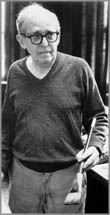


Al Morch from the San Francisco Examiner:
"David Sutherland has managed a coup--having the subject be the host/narrator and still emerge
with a magnificent portrait of a maverick satirist and social commentator."
Michael Blowen from The Boston Globe:
"The symbiosis between director and subject is so pure that nothing distorts the relationship between
audience and artist."
 Feasting on the Art of 'Jack Levine'
Feasting on the Art of 'Jack Levine'
By Suzanne Muchnic
Los Angeles Times: September 23, 1986
"I made quite a splash in the '30s, but since then I've become
less and less known," says the 70-year-old painter in David Sutherland's
new film, Jack Levine: Feast of Pure Reason. His recent obscurity
makes Levine an ideal subject for Sutherland, who champions nettlesome
American artists whose careers have long since crested.
. . . A political satirist, Levine hit his stride while painting big-headed,
small-minded power mongers at a gangster's funeral or double-dealing in
smelly closets. Far more than a caricaturist, the Boston native also has
painted empathic portraits and sumptuously exotic interpretations of
Jewish lore, during a period as a self-proclaimed "propagandist for the
Old Testament."
Sutherland puts Levine's life together collage-style, patching his Works
Progress Administration stint, a choked-up testament to his deceased
wife (painter Ruth Gikow) and reminiscences on art and baseball with art
historian Milton Brown between backward looks at his painting and the
on-the-spot creation of a portrait of his daughter, Susanna.
The result is a thoroughly engaging picture of Levine, as fractured in
form but fundamentally sound as his best paintings.
Levine's artist-as-outsider lament is such a cliche that it's tiresome,
and it's tough to take seriously a claim that "I want to remain the mean
little man I always was" from an artist so obviously crying for
recognition.
But exposing the humanity of that stance is surely part of Sutherland's
mission. He wants us to like his chosen artists even as we renew respect
for their contributions. On both counts, he is successful.

- Blue Ribbon, American Film Festival- 1987
- Gold Plaque, Chicago International Film Festival for Documentary Features- 1986
- CINE Golden Eagle- 1986
- Selected by the Academy of Motion Pictures Foundation for its series featuring the outstanding documentary films of 1986
- Chosen by The Boston Herald as one of the ten best movies of 1986

|